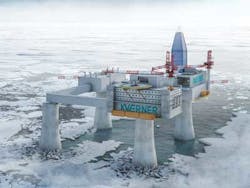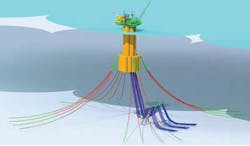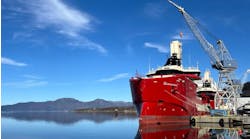Concrete drilling platform could extend exploration season offshore northern Russia
Nick Terdre
Contributing Editor
Finding ways to extend the exploration drilling season in Russia's ice-laden Arctic waters is a key issue both for Russian oil companies and the international oil companies working with them in joint ventures. One concept they are considering is Kvaerner's CONDRILL relocatable concrete-base drilling platform.
Kvaerner holds the concrete platform expertise accumulated since the 1970s and 1980s when Norwegian Contractors designed and built the giant CONDEEP platforms in the North Sea. Knudsen himself is a Norwegian Contractors veteran with 30 years' experience in this field. In the 1990s Kvaerner extended the concept to ice regions when it delivered the first production platform to be installed offshore Newfoundland for the Hibernia field, and it is now building the Hebron platform for the same waters.
Since the turn of this century the company has established a presence in Russia, designing and building three platforms with gravity-base structures (GBSs) which are producing hydrocarbons off Sakhalin Island in the Russian Far East. Two were delivered in 2005 to the Sakhalin II development operated by the SEIC consortium led by Shell, and one in 2012 to ExxonMobil's Sakhalin I project.
All are production platforms, intended to stay in place for several decades. With the CONDRILL, however, Kvaerner is for the first time taking on the drilling challenge. It has been working on the new concept over the past couple of years in response to requests for a GBS solution for exploration drilling off Russia's north coast, says Knudsen. Here, when floating ice appears over the horizon, conventional rigs have to start preparing to halt operations and move away. Farther east along the coast toward the East Siberian Sea, the open-water season becomes progressively shorter, and exploration drilling can be restricted to one well per year. As a result these areas are under-explored, even though considered prospective.
Concrete is a good material for the Arctic, says Knudsen. It can withstand the harsh environment, including the ice loadings and grinding of ice on the legs, while requiring virtually no maintenance. The Sakhalin platforms are designed to withstand drifting ice, temperatures down to -44ºC (-47.2°F), seismic disturbances on the seabed, and, crucially, enable year-round drilling.
The CONDRILL concept takes these properties and transfers them to the concrete equivalent of a mobile rig. Like the GBS production platforms, its stability is secured by skirts which sink into the seabed, creating a vacuum between the bottom of the concrete base and the seabed. The platform can be refloated by pumping water into the skirt compartments and deballasting the structure. As the platform is not intended to stay in any one location for more than a few months, the skirts are relatively short, at about 5 m (16.4 ft). The platform can be relocated in most ice conditions – up to 70% ice concentration and 1.5 m (4.9 ft) thickness – using a combination of ice breakers and ice-class tugs. Relocation can be performed in a matter of days, depending on the distance to the next drill site.
Ice conditions off Russia's north coast are more testing than off Sakhalin, with thicker ice and the possibility of multi-year ice in some areas. So Kvaerner has been testing concrete for even higher ice loads. There are other challenges, though not linked to the issue of concrete, such as logistics and getting personnel and supplies to the drilling rig in remote locations.
The CONDRILL is designed to operate in relatively shallow waters – from 20 to 60 m (65.6 to 197 ft). That covers a lot of acreage mostly close to the north coast. The GBS has the same basic design as the Sakhalin platforms, consisting of four shafts 40 m (131 ft) high supported by a rectangular base 13 m (42.6 ft) high and measuring 130 x 100 m (425 x 328 ft). With a concrete volume of between 50,000 and 100,000 cu m (1.77 MMcf and 3.53 MMcf), it is roughly the same size as the Sakhalin platforms.
The substructure is capable of bearing a topsides load of 20,000 metric tons (22,046 tons), well beyond the normal requirement of a mobile drilling rig. "They look overproportioned compared to the size of the topsides," says Knudsen. Topsides equipment is supported on a rectangular deck. Drilling takes place through one of the shafts, while another is used for storage.
For input on the drilling requirements, Kvaerner has worked with Norwegian drilling contractor Odfjell and consulted with other drilling contractors.
A large topsides area is beneficial in light of the logistical challenge, Knudsen says. The platform has to be able to operate in very remote areas beyond the range of helicopters and probably involving several days' travel by boat. It is therefore designed to be self-sufficient for two months' operation, with much greater storage capacity than normal for equipment and consumables such as drill pipe, drilling mud and fluids, as well as accommodation for a 170-person crew.
Another proposal is to make the drilling platform convertible into a production platform so that if, for example, a promising discovery were made, it could be brought onstream relatively quickly. This has already happened with a couple of drilling platforms now operating in production mode off Sakhalin – Orlan, a steel platform, and Molipaq, a hybrid concrete/steel structure.
Though not part of the original concept, conversion to production mode appears feasible, Knudsen claims. Some of the drilling space and storage could be converted to take production equipment, and the legs could be used for oil storage. For drilling purposes the design only provides for diesel fuel storage in the shafts, but oil storage is a standard feature of concrete production platforms, so it should be possible with this drilling platform design. The large topside load capacity and spacious deck should facilitate conversion to a production platform capable of handling medium-size fields.
Concrete has also proved popular in Russia as it allows a high level of local content to be realized, for both manpower and materials supply. Fabrication can be done locally. For Sakhalin, Kvaerner set up its own yard near Nahodka, north of Vladivostok, and trained several thousand workers with no previous experience. It also helped develop ancillary companies engaged in activities such as pipework and welding. Russian content for the two projects totaled 92% for manpower and 97% for purchased materials. High safety levels were also achieved, with no lost-time injuries recorded during the Sakhalin I project's 8 million man-hours.
If the CONDRILL concept is to prove successful, further steps are required. The oil companies would not normally own and operate one of these units – nor for that matter would Kvaerner, which sees its role as designing and building the platform and assisting with its installation and relocation. Ownership and operation would therefore fall to a drilling contractor, which would probably want a guaranteed multi-year contract before committing to the investment. This in turn might require cooperation with the oil company clients.
With Rosneft/ExxonMobil's recently announced discovery in the Kara Sea, the CONDRILL is likely to become reality sooner rather than later. However, the ban on technology exports to Russia's Arctic exploration and production introduced by the US and EU as part of their sanctions against Russia over events in Ukraine may delay progress. Norway, although not a member of the EU, is party to the sanctions. By the time the first unit is ready to be built, it is hoped the sanctions will have been lifted. In the meantime, Knudsen says the company is in regular touch with the Norwegian authorities to ensure that its activities in Russia comply with the law.
CONDEEP Deep Floater
Meanwhile, Kvaerner also sees a role for its concrete technology in providing a production solution for fields in deep Arctic waters, such as the Flemish Pass off Canada's east coast, where Statoil and Husky made the significant Bay du Nord discovery last year.
Kvaerner has supplied two concrete-hulled floaters operating in the Norwegian sector, the Heidrun TLP and the Troll B semisubmersible platform. Neither has storage, although this feature was included in the first version of the CONDEEP Deep Floater which was developed (but not selected) for Eni's Goliat development in the Norwegian Barents Sea.
As its name suggests, the CONDEEP Deep Floater is based on the CONDEEP concept of cylindrical concrete columns and cells, comprising a central cluster of seven columns around the base which are arranged 12 smaller cells capped with spherical domes. The cells are used either for oil storage, providing capacity of 1.4 MMbbl, or for water ballast and buoyancy. The storage cells are under-pressured so that in the event of a rupture, the oil will not leak out.
The water depth in the Flemish Pass is 1,100 m (3,609 ft), compared to 380 m (1,247 ft) for Goliat. The design therefore has a deeper draft than the earlier version to make it more stable, Knudsen says. The risers, which are deployed through the central columns, are thus only exposed to the open sea where they exit the base of the platform at a depth of 100 m (328 ft), well out of reach of icebergs.
At the bottom of the hull the overall diameter is greater than that of the upper part. This, combined with a bilge keel arrangement, results in good stability characteristics – motions are very small during normal operations and moderate in 100-year weather conditions.
The hull, which can support a topsides with an operating weight of 40,000 metric tons (44,092 tons), is made of high-strength concrete which is iceberg resistant. It is moored by 16 to 18 chain-wire-chain lines attached to suction anchors. Solutions are under review for a disconnection system for the moorings and the risers in the event that approaching icebergs force the platform to move, as has happened with some FPSOs in Newfoundland & Labrador's Iceberg Alley.
Statoil and its partners have shown interest in the concept. "It's on their radar and we're optimistic that as they start to plan the development of the field they will include this as one of their options," Knudsen says. But with four more wells planned on its Flemish Pass licenses, Statoil has a further phase of drilling to complete before it starts focusing fully on development.






